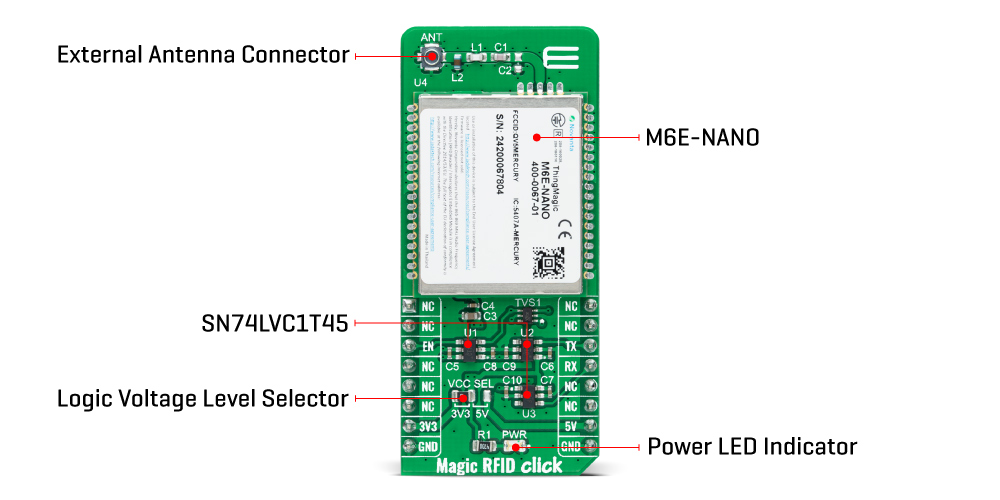OFF
GO LOCAL
| Company | Stock | Price |
|---|---|---|

MIKROE-4425
22 g
Status:
Magic RFID Click is a compact add-on board that contains an embedded RFID module. This board features the M6E-NANO, UHF RFID module with ultra-low power consumption from JADAK. Supporting the EPC Gen2V2 and ISO 18000-63 standard, the M6E-NANO module is available for global use. It operates in the Ultra High Frequency (UHF) band in a range from 859 up to 930MHz and can be used for write/read applications. This module provides an output power of +27 dBm, adjustable in 0.01 dB steps with a read speed of 200 tags/sec, meaning that with the appropriate antenna and the configuration of the module itself, greater distances can be achieved (up to 4.5m). This Click board™ is ideal for a wide range of applications in the logistics, security access points, manufacturing, tag commissioning stations, and more.
Magic RFID Click is supported by a mikroSDK compliant library, which includes functions that simplify software development. This Click board™ comes as a fully tested product, ready to be used on a system equipped with the mikroBUS™ socket.
This product is no longer in stock
Availability date:
OFF
| Company | Stock | Price |
|---|---|---|

Magic RFID Click is based on the M6E-NANO, Ultra High Frequency embedded RFID module with ultra-low power consumption from JADAK. Supporting the EPC Gen2V2 and ISO 18000-63 standard, the M6E-NANO module is available for global use. It can be customized for frequencies in many global regions like the Americas, European Union (EU), India, Korea, Australia, China, and Japan. The ThingMagic‘s M6E-NANO module operates in the UHF band from 859MHz up to 930MHz used for write/read applications. This module provides an output power of +27 dBm, adjustable in 0.01 dB steps with a read speed of 200 tags/sec, meaning that with the appropriate antenna and the configuration of the module itself, greater distances can be achieved (up to 4.5m).

Magic RFID Click supports one monostatic bidirectional RF antenna through edge vias. The maximum RF power delivered to a 50Ω load from each port is 0.5W or +27 dBm. The performance of the module is affected by antenna quality. Antennas that provide a 50Ω match at the operating frequency band perform best. Specified performance is achieved with antennas providing 17dB return loss or better across the operational range. Damage to the module will not occur for any return loss of 1dB. It only may occur if the antenna is disconnected during operation.
The module communicates with MCU using a UART serial port that supports complete functionality except for the lowest power operational mode with a baud rate from 9600 up to 921600bps. Upon initial Power-Up, the default baud rate of 115200 is used. The UART RX and TX lines are buffered with the SN74LVC1T45, a single-bit dual-supply bus transceiver with configurable voltage translation driven by the M6E-NANO Vout pin. This makes the inputs to 5V tolerant and increases the output current driving capability from 10mA to 15mA.
In order to increase the ESD protection, one TVS diode is added to the EN GPIO line. Enable pin labeled as EN, routed on the CS pin of the mikroBUS™ socket, must be pulled HIGH for the module to be operational. When this pin is in a LOW logic state, it turns the module off and reduces its power consumption to nearly zero.
Magic RFID Click possesses a miniature coaxial N.FL series antenna connector, that can be connected to the appropriate antenna which Mikroe has on its offer, such as Circular UHF RFID Antenna. This antenna represents an excellent choice for all UHF/RFID applications that operate in a frequency range from 902MHz up to 928MHz.
This Click board™ is designed to operate with both 3.3V and 5V logic voltage levels selected via the VCC SEL jumper. It allows for both 3.3V and 5V capable MCUs to use the UART communication lines properly.
Type
RFID/NFC
Applications
Can be used for a wide range of applications in the logistics, security access points, manufacturing, tag commissioning stations, and more.
On-board modules
Magic RFID Click is based on the M6E-NANO, Ultra High Frequency embedded RFID module with ultra-low power consumption from JADAK.
Key Features
Ultra-low power consumption, EPCglobal Gen 2 (ISO 18000-6C), tag read rate of up to 200 tags/second, read range of up to 4.5m, 0 dBm to 27dBm transmit power, and more.
Interface
UART
Feature
No ClickID
Compatibility
mikroBUS™
Click board size
L (57.15 x 25.4 mm)
Input Voltage
3.3V or 5V
Category
Click Boards
This table shows how the pinout on Magic RFID Click corresponds to the pinout on the mikroBUS™ socket (the latter shown in the two middle columns).
| Label | Name | Default | Description |
|---|---|---|---|
| LD1 | PWR | - | Power LED Indicator |
| JP1 | VCC SEL | Left | Logic Level Voltage Selection 3V3/5V: Left position 3V3, Right position 5V |
| Description | Min | Typ | Max | Unit |
|---|---|---|---|---|
| Supply Voltage | 3.3 | - | 5 | V |
| Operating Frequency Range | 859 | - | 930 | MHz |
| Read Range | - | - | 4.5 | m |
| Operating Temperature Range | -40 | +25 | +85 | °C |
We provide a library for the Magic RFID Click as well as a demo application (example), developed using MIKROE compilers. The demo can run on all the main MIKROE development boards.
Package can be downloaded/installed directly from NECTO Studio Package Manager (recommended), downloaded from our LibStock™ or found on MIKROE github account.
Library Description
This library contains API for Magic RFID Click driver.
Key functions
magicrfid_get_response Magic RFID get response function.
magicrfid_parse_tag_rssi This function parses RSSI value of the tag.
magicrfid_parse_tag_epc This function parses EPC bytes of the tag.
Example Description
This example reads and processes data from Magic RFID clicks.
void application_task ( void )
{
magicrfid_response_t rsp = { 0 };
if ( ( MAGICRFID_OK == magicrfid_get_response ( &magicrfid, &rsp ) ) &&
( MAGICRFID_OPCODE_READ_TAG_ID_MULTIPLE == rsp.opcode ) )
{
if ( 0 == rsp.data_len )
{
log_printf( &logger, "rn --- SCANNING ---rn" );
}
else
{
log_printf( &logger, "rn --- TAG DETECTED ---rn" );
int8_t tag_rssi = 0;
uint32_t tag_freq = 0;
magicrfid_epc_t epc = { 0 };
tag_rssi = magicrfid_parse_tag_rssi ( rsp );
log_printf( &logger, " RSSI: %drn", ( int16_t ) tag_rssi );
tag_freq = magicrfid_parse_tag_freq ( rsp );
log_printf( &logger, " FREQ: %lurn", tag_freq );
magicrfid_parse_tag_epc ( rsp, &epc );
log_printf( &logger, " EPC PC: 0x%.4Xrn", epc.epc_pc );
log_printf( &logger, " EPC ID (len: %u): ", ( uint16_t ) epc.data_len );
for ( uint8_t cnt = 0; cnt < epc.data_len; cnt++ )
{
log_printf( &logger, "%.2X", ( uint16_t ) epc.data_buf[ cnt ] );
}
log_printf( &logger, "rn EPC CRC: 0x%.4Xrn", epc.epc_crc );
Delay_ms ( 100 );
magicrfid_clear_buffers ( &magicrfid );
}
}
}
The full application code, and ready to use projects can be installed directly from NECTO Studio Package Manager (recommended), downloaded from our LibStock™ or found on MIKROE github account.
Other MIKROE Libraries used in the example:
Additional notes and informations
Depending on the development board you are using, you may need USB UART click, USB UART 2 Click or RS232 Click to connect to your PC, for development systems with no UART to USB interface available on the board. UART terminal is available in all MIKROE compilers.
This Click board™ is supported with mikroSDK - MIKROE Software Development Kit. To ensure proper operation of mikroSDK compliant Click board™ demo applications, mikroSDK should be downloaded from the LibStock and installed for the compiler you are using.
For more information about mikroSDK, visit the official page.